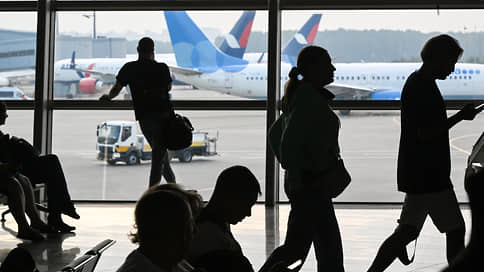Passengers didn’t care about the price
[ad_1]

The revenue of Russian air carriers increased by a third last year, exceeding the record level before the pandemic, although passenger traffic fell back to 2017, ACRA calculated. The profitability of transportation also reached an abnormally high level. In addition to the increase in ticket prices, this was also influenced by an increase in the average flight distance by almost 20% over five years. However, analysts believe that in 2024, airlines’ ability to raise prices will decrease, while costs will continue to rise. Other experts, however, believe that the potential for higher prices for flights will remain and will not lead to a significant reduction in passenger traffic.
The total revenue of Russian airlines in 2023 increased by 31%, to 1.37 trillion rubles, which became an absolute maximum and exceeded the levels of 2019, according to ACRA’s analytical report, which was reviewed by Kommersant. However, when adjusted for inflation, revenue is comparable to 2014-2015 levels, while passenger traffic (105 million people) has returned to 2017 levels.
The industry average RASK indicator (airline revenue per seat-kilometer), according to ACRA calculations, increased by 16% year-on-year. This is mainly due to the increase in ticket prices. Over the past decade, analysts identify two periods of sharp price increases – from 2015 to 2016 and in 2021, when RASK increased by more than 15%. Thus, with average annual inflation in 2013–2023 at about 7%, the average annual increase in RASK over the same period was approximately 6%. According to ACRA, taking into account the inflation accumulated since 2019 (40%), in 2023 the increase in ticket prices only compensated for the “lack of adequate indexation in previous years.” According to ACRA, the increase in RASK by the end of 2024 will not exceed the level of last year.
The second factor in the growth of airline revenue was the increase in the average flight distance – from 1.85 thousand km in 2019 to 2.2 thousand km in 2023. This is due to the development of domestic tourism, which has partly replaced trips abroad, as well as the extension of flight routes to unclosed airports in the south of Russia. This affected both the passenger turnover of the market and the growth of airline costs, which cannot always be passed on to the end consumer.
At the same time, the CASK indicator (carrier costs per seat-kilometer) in 2023 increased by only 2.7%, remaining almost at the 2022 level. As a result, the ratio of carriers’ revenues to expenses per seat-kilometer (RASK/CASK) in 2023 turned out to be an abnormally favorable 1.21. For comparison: in 2012–2019, the dynamics of the RASK/CASK ratio was consistently in the range of 1.04–1.13, and in 2020 it dropped to 0.88 amid the pandemic and lower air ticket prices.
ACRA assesses the likelihood that the aviation market will be able to maintain the RASK/CASK ratio at the 2023 level as low. According to analysts, the most significant increase in air ticket prices has already occurred, and their further significant increase may have a negative impact on traffic volumes. At the same time, operating expenses will continue to grow due to the rise in cost of fleet maintenance and the indexation of personnel costs. As a result, the sector’s revenue in 2024 may be in the range of RUB 1.3–1.6 trillion, and the RASK/CASK ratio will drop to 1.1–1.15.
In the base scenario, ACRA predicts that traffic dynamics in 2024 will remain at a level comparable to 2023 (up to 115 million people). It will be difficult for airlines to show growth primarily due to the limited size of the fleet and the difficulties associated with its maintenance. In a stress scenario—with a tightening of the sanctions regime, as well as an increase in ticket prices—passenger traffic could drop to 85–100 million people. The total revenue of airlines may decrease to 1 trillion rubles, and the RASK/CASK ratio may drop below 1. The airlines interviewed by Kommersant refrained from commenting.
Kommersant’s interlocutor in the aviation industry noted that the operating expenses of the Aeroflot group in 2023 increased, excluding wages and depreciation, by 30%, to 411 billion rubles. At the same time, aircraft maintenance costs increased by more than 80%. Only part of the increase in prices is due to the weakening of the ruble, he adds: the rest is an increase in prices for fuel, components and services. With low transportation margins and a reduction in state support, a Kommersant source believes, carriers will be forced to pass on the increase in flight costs to the passenger.
In addition, from 2022, airlines could not pay for leasing to foreign lessors. After the completion of the insurance settlement, leasing payments will be added to the carriers’ expenses, albeit at a preferential rate, notes Elena Sakhnova, an analyst at the My Investments channel. She also believes that park maintenance costs will continue to rise.
At the same time, according to Ms. Sakhnova, with an inflation rate of 7% and an expected increase in real income of the population of 4%, an increase in ticket prices in the range of 10–11% “will not affect passenger traffic.” And even if tickets become more expensive, this will not lead to a comparable decrease in passenger traffic, since a significant share of it is insensitive to the cost of the ticket. In addition, the expert clarifies, despite the de-bermudization of the fleet, the number of flights abroad is still below pre-crisis values, and there may be some opportunity for raising tariffs on foreign flights, where the share of the premium segment is traditionally higher.
[ad_2]
Source link





